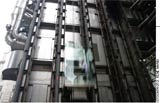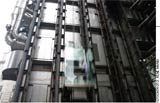
Upward Mobility
An extended apprenticeship program and ongoing training are de rigueur for these professionals.
 Needless to say, the elevator industry has its ups and downs. On the upside, earnings for those who install, repair, and maintain the systems are among the highest of all construction trades, and the benefits are usually good. On the downside, the work involves heavy equipment with moving parts, often cramped quarters, and sometimes very deep shafts.
Needless to say, the elevator industry has its ups and downs. On the upside, earnings for those who install, repair, and maintain the systems are among the highest of all construction trades, and the benefits are usually good. On the downside, the work involves heavy equipment with moving parts, often cramped quarters, and sometimes very deep shafts.
Falls, electrical shocks, muscle strains, and other injuries related to lockout/tagout, confined spaces, scaffolds, cranes, rigging, hoisting, and heavy equipment handling are among the common pitfalls in the field. And if those potential hazards read like OSHA’s annual list of Top Ten Most-Cited Violations for all occupations, it’s because the elevator industry as a whole combines the skills—and risks—of so many other professions.
“The elevator mechanic or technician is really a blend of many trades,” says Gregg Laufersweiler, service sales and marketing manager for Stanley Elevator Co. Inc. in Merrimack, N.H.“A lot of the same hazards you’d have as an electrician, you have as an elevator technician because we’re working with electricity of all voltages and various amperages. We build cabs, but we also build work partitions and barricades to protect other trades and the public from exposed hoistways. We use cranes on a regular basis to rig and hoist equipment up on to roofs. And when we’re working on hydraulic elevators, we’re like plumbers because then we're piping, doing a lot of cutting and threading of pipe. So you really do need to know most all the other trades in order to be a properly qualified technician.”
As might be expected, acquiring the necessary skills for such a multifaceted, technical occupation requires extended and rigorous training. Most installers and repairers learn the trade in an apprenticeship program administered by local joint educational committees representing the employers and the industry’s union, the International Union of Elevator Constructors. With some 26,000 members—or three of every four workers in the field—IUEC boasts one of the highest membership proportions of all occupations. The five-year programs combine paid on-the-job training with classroom instruction in subjects such as math, physics, electrical and electronic theory, and safety.
Apprentices typically assist experienced installers and repairers by toting equipment, bolting rails to walls, and assembling the cabs; eventually, they graduate to the more technical tasks such as wiring. After completing the program, apprentices must pass the standard licensing exams that most cities and states require. The National Association of Elevator Contractors offers programs for additional certification, such as a Certified Elevator Technician or Certified Accessibility and Private Residence Lift Technician.
Workers tend to specialize in either the construction, electronic, or repair and troubleshooting ends of the business. Among the most highly skilled and paid workers in the trade, “adjusters” specialize in fine-tuning all of the equipment after installation, ensuring the units operate according to specifications and stop correctly at each floor within a specified time.
Because so much is riding on the work—namely, the public— the elevator industry is heavily regulated. National standards exist for all facets of the trade, down to the torque the closing elevator doors can have, but codes vary by state.
Going Up?
Because of the intricate, redundant, and regulated safety features built in to every elevator, catastrophes are rare outside of movies and TV. For traction or “rope” elevators, one rope (actually a woven steel cable) can support the weight of the elevator cab and the counterweight on its own, but individual units are typically built with between four and eight cables to ensure safety. Additional safeties are activated by a governor on the sheave when the elevator moves too quickly. Both traction elevators and the less-versatile hydraulic elevators have automatic braking systems near the top and bottom of the shaft; these are backed up by electromagnetic brakes that engage when the cabs come to a stop. At the bottom of the shaft is a heavy-duty shock absorber system designed to save passengers if all else fails.
“Elevators shut down a lot in our business, but they do because they’re designed that way. The last thing you want is an elevator running when you have a safety circuit that’s tripped or open,” Laufersweiler says. “I don’t know the exact number, but a large percentage of the reason people get stuck on an elevator is because the elevator wants them to be. It’s designed to protect the passengers.”
Laufersweiler adds that most modern elevators are microprocessor based. When you press the button to choose your floor, you’re performing data entry. For taller buildings, advanced programs are sometimes used that take passenger traffic patterns into account. Otherwise, from the electronic eye that controls the opening and closing of the doors to the load sensors in the car floor and the magnetic or light sensors built into the elevator shaft corresponding to the floor numbers, operation is controlled by computers.
As elevator equipment and controls become increasingly sophisticated, workers have to stay on top of the technological advances, of course. Ongoing, career-long training for workers in the field is paramount, whether their specialty is installing new systems, modernizing older ones, or maintaining the ones in place.
This article originally appeared in the March 2009 issue of Occupational Health & Safety.